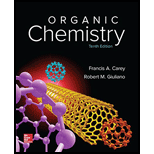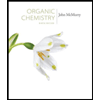
Organic Chemistry - Standalone book
10th Edition
ISBN: 9780073511214
Author: Francis A Carey Dr., Robert M. Giuliano
Publisher: McGraw-Hill Education
expand_more
expand_more
format_list_bulleted
Concept explainers
Textbook Question
Chapter 9, Problem 30P
Show by writing appropriate chemical equations how each of the following compoundscould be converted to
a)
b)
c) Acetylene
d)
Expert Solution & Answer
Want to see the full answer?
Check out a sample textbook solution
Students have asked these similar questions
Based on naming branched alkyl substituents, and draw all possible alkyl groups having the formula C5H11–. Give the IUPAC names for the eight compounds of molecular formula C10H20that contain a cyclopentane ring with each of these alkyl groups as a substituent.
Draw a structural formula for compound.
Q.) 1,3-Cyclohexanedione
Provide a molecule that contains the indicated functional groups and molecules. Each functional group must be single on your examples. Give an IUPAC accepted name for your molecules.
a) Bicyclo compound: Alcohol (alcohol functional group must be on the 3° carbon atom), alkene, one cyclohexane and one cyclopentane.
Plz do Asap ...! And send ur ans in clear manner ...!
Chapter 9 Solutions
Organic Chemistry - Standalone book
Ch. 9.1 - Prob. 1PCh. 9.2 - Prob. 2PCh. 9.4 - How do bond distances and bond strengths change...Ch. 9.5 - Complete each of the following equations to show...Ch. 9.6 - Prob. 5PCh. 9.6 - Which of the alkynes of molecular formula C5H8 can...Ch. 9.7 - Give the structures of three isomeric dibromides...Ch. 9.7 - Prob. 8PCh. 9.9 - Write a series of equations showing how you could...Ch. 9.9 - Write a series of equations showing how to prepare...
Ch. 9.10 - Prob. 11PCh. 9.11 - Give the structure of the enol formed by hydration...Ch. 9.11 - Prob. 13PCh. 9.13 - Prob. 14PCh. 9.14 - Prob. 15PCh. 9 - Provide the IUPAC name for each of the following...Ch. 9 - Prob. 17PCh. 9 - All compounds in Problem 9.17 are isomers except...Ch. 9 - Prob. 19PCh. 9 - Write structural formulas for all the alkynes of...Ch. 9 - Prob. 21PCh. 9 - Prob. 22PCh. 9 - The alkane formed by hydrogenation of...Ch. 9 - Write the structure of the major organic product...Ch. 9 - Write the structure of the major organic product...Ch. 9 - When 2-heptyne was treated with aqueous sulfuric...Ch. 9 - Prob. 27PCh. 9 - Prob. 28PCh. 9 - Prob. 29PCh. 9 - Show by writing appropriate chemical equations how...Ch. 9 - Show by writing appropriate chemical equations how...Ch. 9 - Diphenylacetylene can be synthesized by the double...Ch. 9 - (Z)-9-tricosene [ (Z)-CH3(CH2)7CH=CH(CH2)12CH3 ]...Ch. 9 - Prob. 34PCh. 9 - Prob. 35PCh. 9 - Prob. 36PCh. 9 - Alkynes undergo hydroboration to give...Ch. 9 - Prob. 38DSPCh. 9 - Prob. 39DSPCh. 9 - Prob. 40DSPCh. 9 - Prob. 41DSPCh. 9 - Thinking Mechanistically About Alkynes The...
Knowledge Booster
Learn more about
Need a deep-dive on the concept behind this application? Look no further. Learn more about this topic, chemistry and related others by exploring similar questions and additional content below.Similar questions
- Hello, please draw and name the organic molecules according to the following criteria (draw the entire structure out clearly with each C and H and other atoms and name it) a) The molecule must have a benzene, could potentially have a rxn with H2 using a platinum catalyst and has at least one branch b) The molecule must have an alcohol R-chain, could produce a carboxylic if reacted with KMn04 and has contains two or more branchesarrow_forwardWrite structural formulas for compounds that meet the following descriptions:(a) A 6-carbon alkene whose longest chain is 4 carbons inlength (three possibilities)(b) An alkyne with 5 carbons total (three possibilities)(c) A monosubstituted benzene with a total of 8 carbons(one possibility)(d) A disubstituted benzene with a total of 8 carbons(three possibilities)arrow_forwardPlease be clear in your writing The following names may have some errors. Correct the name and render the structures corresponding to the following names. g) 1,3-pentadiino h) cyclohexylacetylenearrow_forward
- Read Appendix B on naming branched alkyl substituents, and draw all possible alkyl groups having the formula C5H11–. Give the IUPAC names for the eight compounds of molecular formula C10H20 that contain a cyclopentane ring with each of these alkyl groups as a substituent.arrow_forwardUsing condensed structural formulas, write a balancedchemical equation for each of the following reactions:(a) hydrogenation of cyclohexene, (b) addition of H2O totrans-2-pentene using H2SO4 as a catalyst (two products),(c) reaction of 2-chloropropane with benzene in the presenceof AlCl3.arrow_forwardDraw the following compound. If, and only IF, the name is inappropriate give the correct name of thecompound and draw 2 isomers of the compounds FROM below, and state the type of isomerism. a.) 3-chloro-4-bromohexaneb.) 2-methyl-3-oxo-5-pentanolc.) 1-octylcycloheptaned.) 1-bromo-6-chloro-5-phenole.) 1-octanonearrow_forward
- When cyclopropane is treated with HI, 1-idopropane is formed. A similar type of reaction does not occur with cyclopentene or Cyclohexane. Suggest an explanation for cyclopropane’s reactivity.arrow_forwardDraw the structure of the following compounds (E)-3,7-Dimethyloct-3-ene and Neopentylcyclohexanearrow_forwardDraw three-dimensional structures for each of the following compounds:a. (R)-3-methylhexaneb. (1S, 2R)-1-chloro-2-tert-butylcyclohexanearrow_forward
- Give the structure of each of the following compounds. b) 1-butyl-4-propylcyclohexanearrow_forwardDraw the skeletal structures for the compounds in a. (Z)-1,3,5-tribromo-2-pentene b. (Z)-3-methyl-2-heptenec. (E)-1,2-dibromo-3-isopropyl-2-hexene d. vinyl bromidee. 1,2-dimethylcyclopentene f. diallylaminearrow_forwardThere are two compounds with the name 2-methyl-3-hexene, but only one with the name 2-methyl-2-hexene. Ex-plain with structures.arrow_forward
arrow_back_ios
SEE MORE QUESTIONS
arrow_forward_ios
Recommended textbooks for you

Nomenclature: Crash Course Chemistry #44; Author: CrashCourse;https://www.youtube.com/watch?v=U7wavimfNFE;License: Standard YouTube License, CC-BY